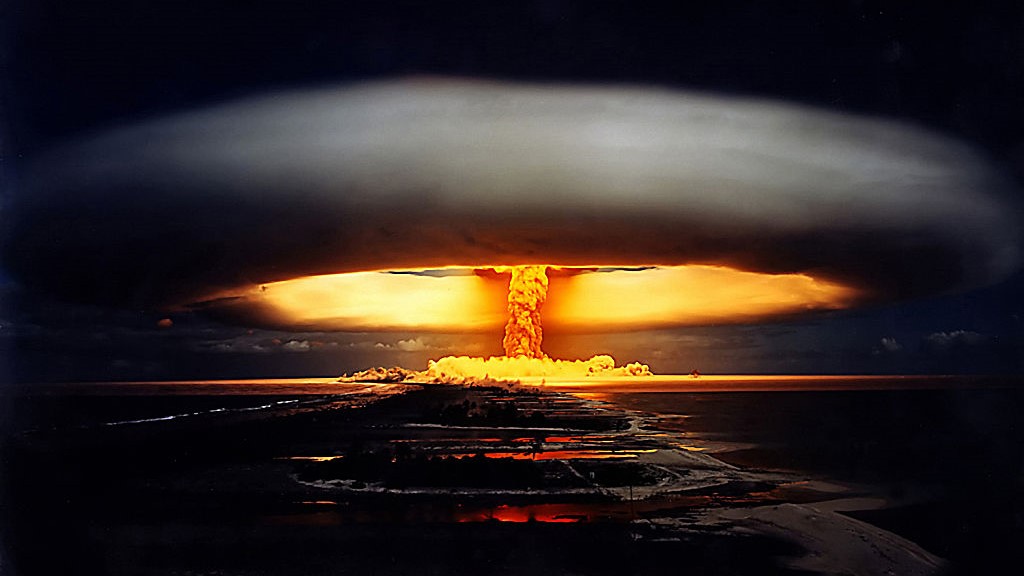Nuclear bombs set off new geological epoch in the 1950s, scientists say
Nuclear testing in the 1950s marked sediments at the bottom of a lake in Canada to such an extent that scientists are calling for it to become the symbol of a new geological epoch: the Anthropocene.
Nuclear weapons testing in the 1950s and early 1960s left the first obvious and indelible marks of "overwhelming" human activity on Earth, and these events may signal the beginning of a new geological epoch known as the Anthropocene, geologists say.
Fallout from these tests snowed down from the atmosphere and became trapped in the earth as layers of sediment rich in a radioactive form of plutonium, called plutonium-239.
Scientists argue that blankets of plutonium-239-rich sediment at the bottom of a small lake in Canada present the earliest tangible record of human activities shifting the balance of natural systems — which is why they're naming this potential new epoch "anthro" after humans.
"The presence of the plutonium mark is a simple tool to allow us to define that boundary," Colin Waters, an honorary professor at the University of Leicester in the U.K. and the chair of the Anthropocene Working Group (AWG), said in a presentation organized by Germany's Science Media Center on July 6. "Because of the above-ground nuclear detonation — the testing that went on in the 1950s — there's a very precise geochemical boundary that is present across the planet, across all environments, that links to the onset of those detonations."
Researchers first proposed a new geological epoch in the early 2000s, after the late Dutch meteorologist Paul Crutzen, who was awarded the Nobel Prize in Chemistry in 1995, coined the term "Anthropocene." This epoch marks the point where humans became the dominant influence on the global climate and environment.
Related: We are now living in a new geologic age, experts say
Crutzen set the boundary during the Industrial Revolution and argued that James Watt's design of the steam engine in 1784 marked a turning point.
Get the world’s most fascinating discoveries delivered straight to your inbox.
But Crutzen's starting point for the Anthropocene is invisible outside of Europe, which was the center of industrialization in the 18th century, Waters said. "In the Southern Hemisphere there is no effect; the sediments just do not show any significant effect from the Industrial Revolution."
While the newly proposed boundary is visible in sediments all over the world, geologists with the AWG chose Crawford lake in Ontario to designate the end of the previous epoch, the Holocene, and the beginning of the Anthropocene.
Crawford lake formed 10,000 years ago when a limestone cave collapsed into underground waterways, forming a deep sinkhole, Francine McCarthy, a professor of earth sciences at Brock University in Canada and a voting member of the AWG, said in the presentation. This shape prevents the surface water from mixing with the bottom layers, meaning the lake acts as a funnel for particles raining down through the water column. In the warm summer months, particles of calcite from the limestone rocks crystallize and fall to the lake bed, where they form a white coating that contains information about the atmospheric and hydrospheric conditions in that year.
"It is that white layer that we can count and we can identify exactly each year we're looking at," McCarthy said. The record at Crawford lake indicates 1950 is the point when humans "overwhelmed" Earth systems, propelling an era that is "geologically different from before," she added.
The AWG's latest results are published in a special issue of the journal The Anthropocene Review.

Sascha is a U.K.-based staff writer at Live Science. She holds a bachelor’s degree in biology from the University of Southampton in England and a master’s degree in science communication from Imperial College London. Her work has appeared in The Guardian and the health website Zoe. Besides writing, she enjoys playing tennis, bread-making and browsing second-hand shops for hidden gems.



